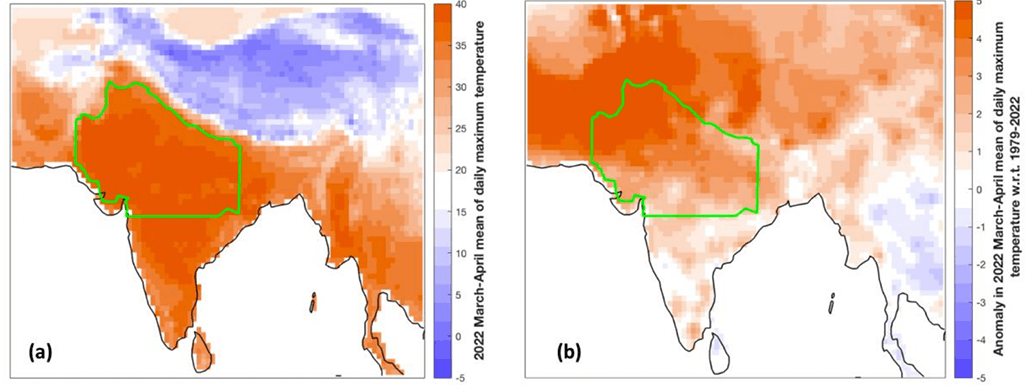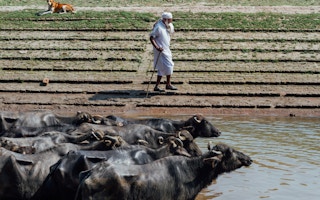The heatwave – responsible for at least 90 deaths across India and Pakistan, as well as wheat crop failures, power outages and forest fires – was also made 1C hotter by human-driven warming, according to the findings.
The results, from an international team of climate scientists at the World Weather Attribution initiative, also show that such heat could become a further 2-20 times more likely if global temperatures reach 2C above pre-industrial levels, the upper limit of the Paris Agreement.
In April, temperatures in Pakistan reached 49C and above 47C in parts of India.
At a press briefing, Indian climate scientists warned that further increases in heat and humidity in Asia “could lead [to] approaching the limits to what adaptation could give us”. They added there was an urgent need to consider this in heat action and adaptation plans.
“
We know that heatwaves are going to come earlier, stay for longer and be more intense across the Indian subcontinent. Adapting to this increasing heat risk is critical.
Dr. Chandni Singh, senior researcher, Indian Institute for Human Settlements
The findings are the latest in “attribution science”, which has linked human-caused climate change to deadly floods in South Africa, damaging cyclones in southern Africa and record heat in the US, among hundreds of other extreme weather events.
Heat goes on
Parts of South Asia, including India and Pakistan, first began to suffer from extreme heat in March.
India recorded its hottest March since records began 122 years ago, according to the Indian Meteorological Department (IMD) – with temperature records broken in Delhi, the western Himalayas, and the plains of Punjab, Haryana, Rajasthan and Uttar Pradesh.
The heatwave conditions continued throughout April, with Pakistan recording temperatures of 49C and seeing 30 per cent of its land area affected by extreme heat.
Severe impacts were recorded in both countries – with heat exposure warnings issued, schools closed, power grids destabilised and working hours lost to extreme conditions.
The new analysis focuses on extreme temperatures recorded in north-western India and south-eastern Pakistan over these two months.
The researchers focused on the two months because the heat was unusually severe for the time of year in the region, explains Dr Friederike Otto, co-leader of WWA and a senior lecturer in climate science at Imperial College London. She told a press briefing:
“We are looking at what was really exceptional about this heatwave and that was that it started so early and is still having a really long duration. So our focus here is March and April.”
(The heat continued into May, with Pakistan recording temperatures of 51C and India seeing temperatures of 49.2C.)
Fingerprint of climate change
To examine the role of climate change in the heatwave, the researchers first looked at records of maximum daily temperatures in north-western India and south-eastern Pakistan to see how they have changed with global temperature rise. (Global temperatures have already risen by around 1.2C since the start of the industrial era.)
The maps below show average daily temperatures (left) and temperature anomalies from March to April across India and Pakistan, with the study area highlighted in green. (Anomalies show how much higher temperatures were when compared to the average from 1979 to 2022.)

Average daily temperatures (left) and anomalies (right) from March to April 2022 across India and Pakistan, with study area in green. Credit: Zachariah et al. (2022)
For the next part of the research, the scientists used climate models to compare the chances of a heatwave like India and Pakistan’s 2022 event occurring in today’s climate with a world without human-caused climate change.
The results show that, at present, such a heatwave is likely to occur once in every 100 years – meaning it is still a relatively “rare” event.
However, in a world without climate change, such a heatwave would only occur once every 3,000 years. This means human-caused climate change has caused such events to become 30 times more likely.
The research team also used climate models to make projections about how the likelihood of such events could change in the future.
The results show that, if global temperatures rise to 2C above pre-industrial levels, such heatwaves could become two to 20 times more likely and 0.5 to 1.5C hotter.
The results differ from a separate analysis released by the UK Met Office last week, which found record-breaking heat in India and Pakistan has been made 100 times more likely as a result of human-caused climate change.
At the press briefing, Otto explained that the two analyses used different parameters, with the Met Office focusing on a 2010 heatwave that affected a different part of India and Pakistan from May to June. In their analysis, the UK Met Office imagined that this heatwave had instead occurred in 2022.
Nevertheless, the scientists conceded that their results are likely to be “conservative” – largely due to a lack of long-term climate data for the India and Pakistan region. Otto added:
“The real result is probably somewhere between ours and the Met Office result for how much climate change increased this event.”
‘Transformational adaptation’
An important factor of the extreme heat in March and April is that it had unequal impacts, with some sections of South Asian society particularly vulnerable, says Aditi Kapoor, a climate resilience advisor at the Red Cross Red Crescent Climate Centre. She told a press briefing:
“[The heat] was something that was very difficult for people to actually bear, especially for daily vendors, the most vulnerable and exposed people who run their livelihoods outside – street vendors, construction workers, farm workers, even the traffic police.”
There is an “important” need to “strengthen” heat action and adaptation plans in India and Pakistan, she said, adding that India has already rolled out “about 130” such plans for cities and towns in the country.
Though the need for investment in adaptation remains crucial, it is also important to recognise that further increases in heat and humidity in Asia could create conditions that are unadaptable for humans, adds Prof Krishna AchutaRao, head of the centre for atmospheric sciences at the Indian Institute of Technology Delhi. He told a press briefing:
“One of the consequences of a warming climate is an increased humidity and so we need to be cognisant of the fact that, while our study does not deal with humidity at all, there is an added dimension to future changes that could lead to issues where we might be approaching the limits to what adaptation could give us.”
The findings strengthen the need for “transformational adaptation” across India, adds Dr Chandni Singh, a senior researcher at the Indian Institute for Human Settlements and a lead author for the recent climate impacts report by the Intergovernmental Panel on Climate Change (IPCC), who was not involved in the analysis. She tells Carbon Brief:
“We know that heatwaves are going to come earlier, stay for longer and be more intense across the Indian subcontinent. Adapting to this increasing heat risk is critical and must be targeted towards those population and livelihood groups that are least able to stay indoors or cool their homes.
“While several Indian cities have heat action plans and early warnings for heatwaves, a lot of implemented adaptation remains incremental and falls short of calls for ‘transformational adaptation’. Transformational adaptation for heat would involve a complete shift in how we build our cities – more space for nature, more ventilation, revised building codes – how we work – shifting work timings, providing cool shelters for exposed livelihoods – and supporting the most vulnerable who are most at risk.”
Echoing AchutaRao, she added:
“It is important to recognise that one cannot adapt to extreme heat endlessly – deep mitigation is the longer-term solution.”
The findings are not yet published in a peer reviewed journal, but use well-established methods.
This story was published with permission from Carbon Brief.








